John McConnell devoted his life to "peace, justice and the care of Earth," a global vision, fueled by missionary zeal, that stems from his youth.
 |
| Photo of John McConnell, Founder of Earth Day and Earth Trustees. |
John was born in Davis City, Iowa on March 22, 1915. He passed from this life in the presence of his devoted wife, Anna, and a few friends in Denver, Colorado, on October 20, 2012, at the age of 97.
Throughout his life, John was a visionary and an actionary. He traveled a path not only less taken but a path often unimaginable by others. He advocated peace through understanding long before that concept became a cliché. He saw justice not as an eye for an eye but as an equitable sharing of all Earth’s resources. He stated that, without peace and social justice, the environmental movement was a one-legged stool.
John’s father and mother, J. S. and Hattie McConnell, were evangelists who traveled the country, preaching and singing God's Word. The family, which included six children, lived in a converted panel truck that bore their beds and kitchen. John, the eldest, received little formal education but invested much time reading books in libraries and gathering impressions of people from nearly every state in the nation.
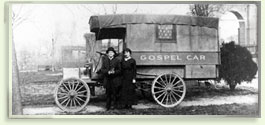 |
| J.S. and Hattie McConnell stand beside their Gospel
Car. December, 1912. |
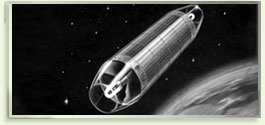 |
| Famous industrial designer Raymond Loewy illustrated
John McConnell’s Star of Hope satellite concept in 1958. |
 |
| Children hold Earth Flags at the 1993 Earth Day ceremony
at the United Nations. |
John's observations of nature's raw beauty, before highways and billboards, sparked his environmental endeavors. In the 1930s, while the government and populace were focused on The Depression, The Dust Bowl and bread lines, John worked with chemist Albert Nobell to produce a plastic from walnut shells, a California waste product.
In 1957, as a newspaper owner/editor in North Carolina, John burst upon the international scene by writing and publishing an editorial that promoted cooperative space exploration between the United States and Russia. The editorial recommended that Earth's two world leaders end the Cold War and launch a satellite that would carry a solar-powered beacon, visible from Earth, that would symbolize a Star of Hope for all people. The Star of Hope satellite, per se, was never launched but John's vision was eventually realized in U.S. and USSR space ventures, such as the Mir Space Station.
In 1963, John worked with major radio and television executives to broadcast his idea for a Minute of Peace, 60 seconds of media silence during which listeners were encouraged to contemplate peace. This idea gained momentum at the closing of the nation's 30-day Period of Mourning for assassinated President John F. Kennedy. Minute for Peace messages were broadcast worldwide through the United Nations in 1965. The practice is still evident, usually without credit to John McConnell, at the UN and religious and political venues.
In 1968, John was inspired by photographs of Earth taken from outer space and created the original Earth Flag, which has since been flown in most countries of the world, the North Pole, the South Pole and aboard Mir.
About the same time, in the height of his career, John conceived Earth Day, a global holiday to be celebrated on the spring equinox (March 20 or 21). He announced the idea at a United Nations conference in San Francisco in November 1969. The city of San Francisco and other communities in California, Colorado and the East Coast adopted the idea, and the first Earth Day occurred on March 21, 1970. At the same time, U.S. Senator Gaylord Nelson was promoting an
Environmental Teach-In, patterned after Vietnam War protests, to be held on college campuses on April 22, 1970. The Teach-In organizers "adopted" - some say "stole" - the Earth Day name, and, due to their greater public relations efforts, April 22 has become more well-known, in the U.S., as "Earth Day." The original equinox Earth Day, however, is still celebrated at the United Nations and in most countries of the world.
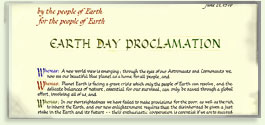 |
| Original Earth Day Proclamation celebrated on the spring
equinox March 21,1970. |
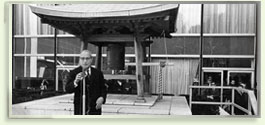 |
| UN Secretary-General U Thant speaks before ringing the
Peace Bell at the First United Nations Earth Day in 1971. |
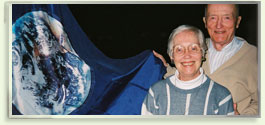 |
| Anna and John McConnell display the Earth Flag outside
their apartment in Denver, Colorado. |
During the 1970s, John worked with mariner Frank O. Braynard, captain Anthony Keasby, anthropologist Margaret Mead and others to found and elevate the Earth Society Foundation, a United Nations nongovernmental organization (NGO) to promote John's vision. As a result, John enjoyed close ties with secretaries-general U Thant and Kurt Waldheim and their highest advisors. Thant rang the United Nations Peace Bell to celebrate Earth Day at the UN in 1971, and Waldheim did the same in 1972.
Since their marriage on Christmas Day 1967, John has enjoyed and benefited from the support of his wife, Anna. The couple lived modestly in a Brooklyn apartment and then moved to a senior housing community in Denver, Colorado, to be near their daughter, son-in-law and grandchildren.
Even into his 90s, John continued to promote his vision. He invested several hours each day updating his essays, talking on the telephone, and sending Internet messages to longtime friends and new acquaintances. He remained motivated by hopes and dreams as well as his awe for Earth's "wondrous skin of life on which our life depends."
He hoped that the Star of Hope would be launched in 2007, 50 years after he first proposed the idea, and that it would serve not only as a symbol for people of Earth but a signal to other sentient beings in our galaxy. He believed that a "peaceful army" of Earth Trustees could initiate "the Battle for Earth that will defeat the enemies of humanity: pollution, poverty, hate, greed, ignorance and strife." He anticipated that these Earth Trustees and their cities and institutions would "seek to benefit people and planet through ecology, economics and ethics." He wished that mass media would "help this moral war by changing their definition of news from 'conflict and change' to 'change without conflict.'" He desired that people "come together where they agree [if nothing else, as Earth inhabitants] while leaving room for their differences." He wanted all nations to "encourage the art and music of every culture" and all faiths to "agree to disagree on creeds but cooperate on deeds for our mutual benefit."
He envisioned global unity through daily observance of a Minute of Peace - at 0300, 1100 and 1900 GMT - in broadcast media, homes, schools and workplaces. He aspired for "a global attitude of mind in which individuals and groups are not trapped in the mistakes of the past … [but] where ancient rules, values and customs that have stood the test of time are revered and applied wherever they can improve life today."
And he dreamt of "a singular annual Earth Day - on the first day of spring - when bells, including the Peace Bell at the United Nations, will ring all over Earth."
To fulfill John McConnell's vision of "peace, justice, care of Earth," become Earth Trustees. Planet Earth needs you!
Written by Robert M. Weir author of John McConnell's biography, originally published as "Star of Hope: The Life and Times of Earth Day Founder John McConnell” and republished as “Peace, Justice, Care of Earth: The Vision of John McConnell Founder of Earth Day” (available through Amazon.com and www.robertmweir.com)


